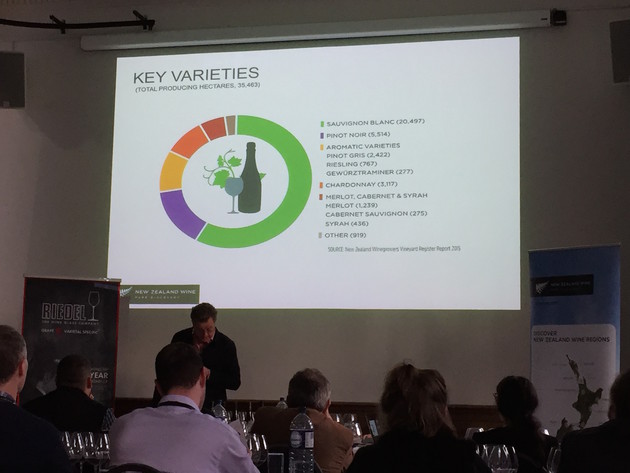
Regionality and terroir: The battle for New Zealand Pinot Noir
Away from its Burgundian origins, Pinot Noir has found a home from home in the cool climates of New Zealand's Marlborough, Nelson and Wairarapa regions.
The popularity of the country's second most planted grape - behind the indomitable Sauvignon Blanc - is clear.
Pinot Noir accounts for 15% of New Zealand's total wine producing hectares (5,514ha out of a total 35,463ha) and sales continue to grow in one of its key markets, the UK (imports were up 10% in 2016).
In terms of geography, Marlborough produces twice as much as the next biggest production area (2,538ha to Central Otago's 1,496ha according to New Zealand Winegrowers Report 2015).
The grape's regional variations were drawn in detail by Peter McCombie at the Wines of New Zealand tasting in London's Royal Horticultural Halls on Monday, where McCombie outlined the nuances of this notoriously fickle grape.
The significance of regionality and whether New Zealand's regions are pronounced or diverse enough to be relevant with consumers often takes centre stage in conversations surrounding the country's development.
As well as being the biggest region for production, Marlborough is also arguably one of the regions which displays the most regional variation.
Although Marlborough is often associated with vibrant red fruit, the region's three main zones, Wairau Valley, the Southern Valleys and Awatere, vary greatly - in nuance as well as quality.
As McCombie said: "There is too much diversity in terms of soils, climatic and topography to easily summarise the Marlborough style in a single sentence.
 Wines of New Zealand's Pinot Noir masterclass 2017 key varieties
Wines of New Zealand's Pinot Noir masterclass 2017 key varieties
"Although over-cropping and young vines have been cited as reasons for lack of complexity, the move away from lighter, stonier soils (typically in the Wairau Valley) to the clay-rich soils in the Southern Valleys at the base of the Wither Hills has arguably been more significant.
"The fact that these new plantings are also hillside sites likely has had an impact on quality. So we can say that Southern Valleys style is richer, with more complexity and structure versus the Wairau. The cooler, windier Awatere Valley Pinots have been likened to a variant of the Southern Valleys style with greater emphasis on floral and herbal aromas and more muscle and weight."
Regional variation arguably has more significance when customers are asked to spend more on a bottle, but even so, McCombie advises caution when thinking about regional styles.
"A relatively straightforward, relatively inexpensive Pinot Noir doesn't need more than 'New Zealand' and it's own brand name. But where there is more ambitious winemaking and expense, regionality has meaning," he said.

|
The first commercial bottling of Pinot Noir in New Zealand was 1987, and the wine has come a long way since then.
While Marlborough reigns supreme in terms of production, it is now finally moving away from its image as a 'less serious' Pinot Noir making region known for lighter, more fruit forward styles, and is now challenging regions like Central Otago and Martinborough in terms of reputation.
While the country's Pinot regions battle to express - and argue - their own distinct regional identities, there is also evidence of a growing maturity in how winemakers deal with the grape's potential for excessive fruit.
"Fruit is a given in New Zealand - there's no shortage of it, but as producers grow more experienced and confident in themselves and their vineyards, they are less likely to chase fruit and more inclined to look for complexity and expression of terroir," McCombie explained.
"Nelson - certainly on the Upper Moutere clays - makes a more structured style, that is less obviously fruity and consequently arguably needs more bottle age.
"Some of the wines have more power, weight and ripeness, but the best producers are trying to let the vineyard speak, rather than extract the maximum fruit and concentration."
As time goes on, winemakers are also putting less emphasis on virgin oak, which was once a hallmark of New Zealand winemaking.
McCombie is happy to see the fad go.
"Like many new regions - and many old ones, undergoing revival - there was a time when more new oak was seen as a good thing. These days, happily, producers are taking their foot off the pedal as with fruit."
Arguably still in its adolescence as a Pinot Noir producing country, New Zealand is proof of how quickly wine regions can hit a growth spurt.
As Mccombie points out - no one had heard of Hawkes Bay ten years ago.
"In New Zealand there are no rules, you can plant where you like. Maybe we will see new sites. As more wine ages I think we will see more vineyards speaking for themselves," he said.

|






